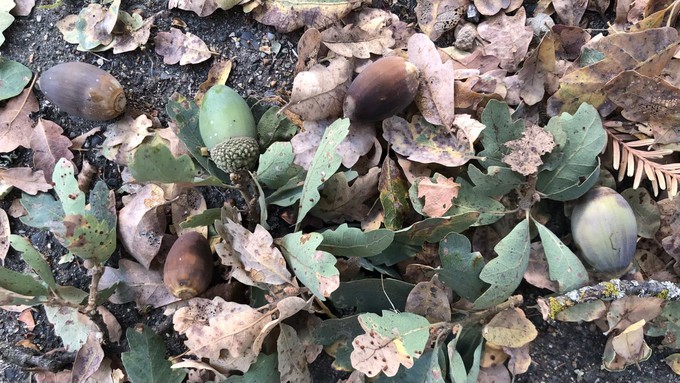
Sacramento Tree Foundation needs volunteers of all ages for gathering acorns

The annual acorn harvest celebrates the beginnings of the life cycle of native oaks. These are acorns and leaves from a blue oak, which is found on the edges of the Sacramento Valley and throughout the foothills. Kathy Morrison
It must be (almost) fall; the acorns are dropping.
Will it be a mast year with a bumper crop of acorns? (That could be a harbinger of a wet, cold winter.) Or will be oak fruit be hard to find?
Either way, the Sacramento Tree Foundation needs those tree nuts to grow a new crop of oaks to plant throughout the region and reforest habitat.
SacTree is hosting two Acorn Harvest Saturdays, Sept. 24 and Oct. 1. Each will be morning-long events, from 8:45 a.m. to noon, but in different locations. Sept 24 will concentrate on Folsom oaks. Oct 1 will harvest trees in Natomas. Specific locations will be provided at registration.
The annual acorn harvest is an important part of SacTree’s mission.
“At the Sacramento Tree Foundation, we steward our urban forest from seed to slab,” say the organizers. “The annual acorn harvest celebrates the beginnings of the life cycle of our native oaks. Acorns are harvested by volunteers, carefully sorted by interns, grown into seedlings by schoolchildren, planted at reforestation sites by volunteers, and stewarded by our staff.
“When trees reach the end of their lifespans, we salvage and sell their wood to further support education and programming around the life cycle of the urban forest.”
This crop of acorns will “grow the next generation of oak trees,” they added. “We provide all the necessary training and supplies to harvest acorns. Participants will receive a short hands-on training on site.
“Register now! The week before this event, we will send a logistics and directions email with detailed information about how to get to the site. You will receive this email only if you are signed up for this planting.
“Anyone but those who live or work nearby are especially encouraged to attend! This event is open to the general public, you do not need any prior experience to join us and on-site training will be provided. Families with children are welcome.”
Space is limited, SacTree adds. Volunteers under 18 years of age must have their parent or legal guardian sign their consent form during registration. Volunteers under 16 years of age must be accompanied and supervised by an adult. One adult chaperone is required for every six youths under age 16, or for every two children under 10.
Volunteers should wear long pants, long sleeves, closed-toe hiking boots or shoes, and sun protection. Dress comfortably and appropriately for the weather. Bring water. Contact with poison oak, ticks, snakes, bees or other wildland hazards is possible. Check in on time at 8:45 a.m. Volunteers must be present for the tool safety demonstration at the start of the event.
For details and registration: https://sactree.org/events/
– Debbie Arrington
Comments
0 comments have been posted.Sacramento Digs Gardening to your inbox.
Sites We Like
Garden Checklist for week of July 21
Your garden needs you!
* Keep your vegetable garden watered, mulched and weeded. Water before 8 a.m. to reduce the chance of fungal infection and to conserve moisture.
* Feed vegetable plants bone meal, rock phosphate or other fertilizers high in phosphate to stimulate more blooms and fruiting. (But wait until daily high temperatures drop out of the 100s.)
* Don’t let tomatoes wilt or dry out completely. Give tomatoes a deep watering two to three times a week.
* Harvest vegetables promptly to encourage plants to produce more. Squash especially tends to grow rapidly in hot weather. Keep an eye on zucchini.
* Pinch back chrysanthemums for bushy plants and more flowers in September.
* Remove spent flowers from roses, daylilies and other bloomers as they finish flowering.
* Pinch off blooms from basil so the plant will grow more leaves.
* Cut back lavender after flowering to promote a second bloom.
* It's not too late to add a splash of color. Plant petunias, snapdragons, zinnias and marigolds.
* From seed, plant corn, pumpkins, radishes, winter squash and sunflowers.